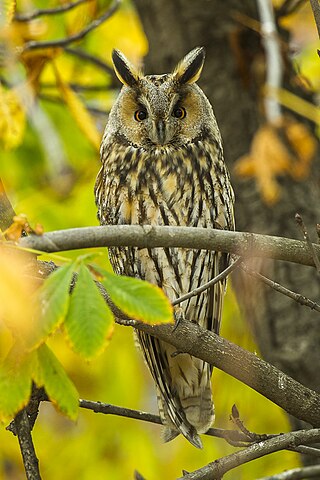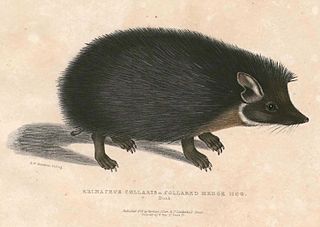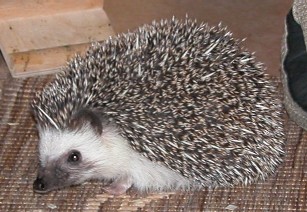
Owls are birds from the order Strigiformes, which includes over 200 species of mostly solitary and nocturnal birds of prey typified by an upright stance, a large, broad head, binocular vision, binaural hearing, sharp talons, and feathers adapted for silent flight. Exceptions include the diurnal northern hawk-owl and the gregarious burrowing owl.

A hedgehog is a spiny mammal of the subfamily Erinaceinae, in the eulipotyphlan family Erinaceidae. There are seventeen species of hedgehog in five genera found throughout parts of Europe, Asia, and Africa, and in New Zealand by introduction. There are no hedgehogs native to Australia and no living species native to the Americas. However, the extinct genus Amphechinus was once present in North America.

Echidnas, sometimes known as spiny anteaters, are quill-covered monotremes belonging to the family Tachyglossidae, living in Australia and New Guinea. The four extant species of echidnas and the platypus are the only living mammals that lay eggs and the only surviving members of the order Monotremata. The diet of some species consists of ants and termites, but they are not closely related to the American true anteaters or to hedgehogs. Their young are called puggles.

The Eurasian eagle-owl is a species of eagle-owl that resides in much of Eurasia. It is also called the Uhu and it is occasionally abbreviated to just the eagle-owl in Europe. It is one of the largest species of owl, and females can grow to a total length of 75 cm (30 in), with a wingspan of 188 cm, with males being slightly smaller. This bird has distinctive ear tufts, with upper parts that are mottled with darker blackish colouring and tawny. The wings and tail are barred. The underparts are a variably hued buff, streaked with darker colouring. The facial disc is not very defined and the orange eyes are distinctive.

The snowy owl, also known as the polar owl, the white owl and the Arctic owl, is a large, white owl of the true owl family. Snowy owls are native to the Arctic regions of both North America and the Palearctic, breeding mostly on the tundra. It has a number of unique adaptations to its habitat and lifestyle, which are quite distinct from other extant owls. One of the largest species of owl, it is the only owl with mainly white plumage. Males tend to be a purer white overall while females tend to more have more extensive flecks of dark brown. Juvenile male snowy owls have dark markings that may appear similar to females until maturity, at which point they typically turn whiter. The composition of brown markings about the wing, although not foolproof, is the most reliable technique to age and sex individual snowy owls.

The long-eared owl, also known as the northern long-eared owl or, more informally, as the lesser horned owl or cat owl, is a medium-sized species of owl with an extensive breeding range. The scientific name is from Latin. The genus name Asio is a type of eared owl, and otus also refers to a small, eared owl. The species breeds in many areas through Europe and the Palearctic, as well as in North America. This species is a part of the larger grouping of owls known as typical owls, of the family Strigidae, which contains most extant species of owl.

The European hedgehog, also known as the West European hedgehog or common hedgehog, is a hedgehog species native to Europe from Iberia and Italy northwards into Scandinavia and westwards into the British Isles. It is a generally common and widely distributed species that can survive across a wide range of habitat types. It is a well-known species, and a favourite in European gardens, both for its endearing appearance and its preference for eating a range of garden pests. While populations are currently stable across much of its range, it is declining severely in Great Britain where it is now Red Listed, meaning that it is considered to be at risk of local extinction. Outside its native range, the species was introduced to New Zealand during the late nineteenth and early twentieth centuries.

Erinaceidae is a family in the order Eulipotyphla, consisting of the hedgehogs and moonrats. Until recently, it was assigned to the order Erinaceomorpha, which has been subsumed with the paraphyletic Soricomorpha into Eulipotyphla. Eulipotyphla has been shown to be monophyletic; Soricomorpha is paraphyletic because both Soricidae and Talpidae share a more recent common ancestor with Erinaceidae than with solenodons.

The long-eared hedgehog is a species of hedgehog native to Central Asian countries and some countries of the Middle East. The long-eared hedgehog lives in burrows that it either makes or finds and is distinguished by its long ears. It is considered one of the smallest Middle Eastern hedgehogs. This hedgehog is insectivorous but may also feed on small vertebrates and plants. In captivity they can live for over 7 years.

Brandt's hedgehog is a species of desert hedgehog native to parts of the Middle East and Central Asia. Its common name derives from its having first been described by Johann Friedrich von Brandt, a director of the Zoological Department at the St Petersburg Academy of Sciences.

The Indian long-eared hedgehog is a small species of mammal native to northern India and Pakistan. It is insectivorous and nocturnal.

The bare-bellied hedgehog, also known as the Madras hedgehog, is a species of hedgehog that is endemic to dry arid regions and scrubby jungles in southeastern India. As it was believed to be rare, it was formerly listed as Vulnerable by the IUCN. It is now known to be locally common in the Indian states of Andhra Pradesh and Tamil Nadu, resulting in its new listing as a species of Least Concern. Hedgehogs are protected species under schedule IV of Wildlife Protection Act (1972).

The four-toed hedgehog, also known as the African pygmy hedgehog, is a species of hedgehog found throughout much of central and eastern Africa.

The southern big-eared mouse, also known as the southern pericote, is a species of rodent in the family Cricetidae. It is found in Argentina and Chile, and is one of only two species in its genus. The type specimen was captured by Charles Darwin in 1834 along the Santa Cruz River in Argentina, during the voyage of HMS Beagle, and was subsequently described by George Robert Waterhouse.

The Cuban funnel-eared bat is a species of bat in the family Natalidae. It is one of two species within the genus Chilonatalus and is found only in the Caribbean.

The Kirthar National Park is situated in the Kirthar Mountains in Jamshoro District in Sindh, Pakistan. It was established in 1974 and encompasses over 3,087 km2 (1,192 sq mi), making it the third largest national park in Pakistan. Wildlife in the park comprises leopard, striped hyena, Indian wolves, honey badger, urial, chinkara gazelles and rare Sindh ibex. Blackbuck are kept in enclosures for a reintroduction project.

The Eurasian eagle-owl may well be the most powerful extant species of owl, able to attack and kill large prey far beyond the capacities of most other living owls. However, the species is even more marked for its ability to live on more diverse prey than possibly any other comparably sized raptorial bird, which, given its considerable size, is almost fully restricted to eagles. This species can adapt to surprisingly small prey where it is the only kind available and to large prey where it is abundant. Eurasian eagle-owls feed most commonly on small mammals weighing 100 g (0.22 lb) or more, although nearly 45% of the prey species recorded have an average adult body mass of less than 100 g (3.5 oz). Usually 55-80% of the food of eagle-owls is mammalian.


















